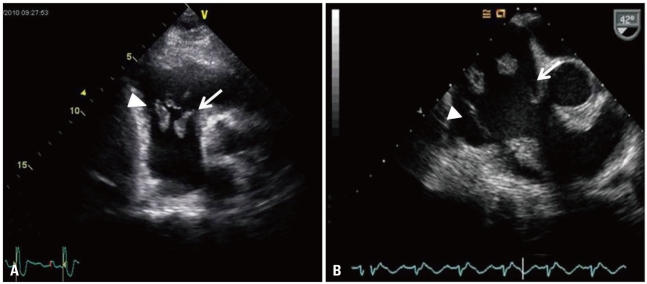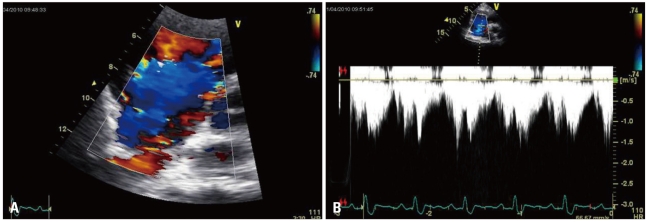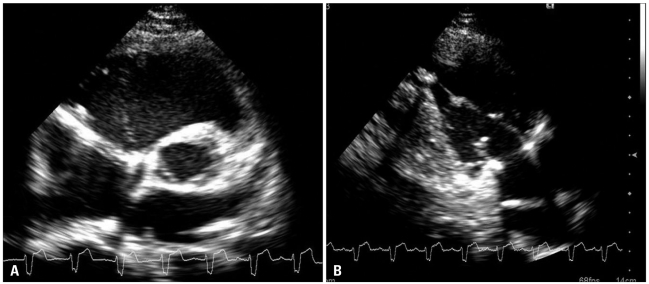1. Schuster I, Graf S, Klaar U, Seitelberger R, Mundigler G, Binder T. Heterogeneity of traumatic injury of the tricuspid valve: A report of four cases. Wien Klin Wochenschr. 2008; 120:499–503. PMID:
18820855.
2. Gayet C, Pierre B, Delahaye JP, Champsaur G, Andre-Fouet X, Rueff P. Traumatic tricuspid insufficiency. An underdiagnosed disease. Chest. 1987; 92:429–432. PMID:
3622022.
3. Kim YJ, Moon KS, Kim JS, Hwang HK. Tricuspid insufficiency detected 8 years later following a blunt chest trauma. Korean Circ J. 1999; 29:1133–1137.
4. Song HJ, Nam SH, Choi YJ, Park SH, Park SH, Han JJ. A case of native valve salvage for 8 years longstanding ruptured tricuspid valve after blunt chest trauma. Korean Circ J. 2004; 34:415–419.
5. Lin SJ, Chen CW, Chou CJ, Liu KT, Su HM, Lin TH, Voon WC, Lai WT, Sheu SH. Traumatic tricuspid insufficiency with chordae tendinae rupture: a case report and literature review. Kaohsiung J Med Sci. 2006; 22:626–629. PMID:
17116624.
6. Nelson M, Wells G. A case of traumatic tricuspid valve regurgitation caused by blunt chest trauma. J Am Soc Echocardiogr. 2007; 20:198.e4–198.e5. PMID:
17275711.
7. Khurana S, Puri R, Wong D, Dundon BK, Brown MA, Worthley MI, Worthley SG. Latent tricuspid valve rupture after motor vehicle accident and routine echocardiography in all chest-wall traumas. Tex Heart Inst J. 2009; 36:615–617. PMID:
20069094.
8. Bertrand S, Laquay N, El Rassi I, Vouhé P. Tricuspid insuffciency after blunt chest trauma in a nine-year-old child. Eur J Cardiothorac Surg. 1999; 16:587–589. PMID:
10609917.
9. Richard P, Vayre F, Sabouret P, Gandjbakhch I, Ollivier JP. Outcome of traumatic tricuspid insufficiency, treated surgically. Apropos of 9 cases. Arch Mal Coeur Vaiss. 1997; 90:451–456. PMID:
9238461.
10. Kulik A, Al-Saigh M, Yelle JD, Rubens FD. Subacute tricuspid valve rupture after traumatic cardiac and pulmonary contusions. Ann Thorac Surg. 2006; 81:1111–1112. PMID:
16488736.
11. Maisano F, Lorusso R, Sandrelli L, Torracca L, Coletti G, La Canna G, Alfieri O. Valve repair for traumatic tricuspid regurgitation. Eur J Cardiothorac Surg. 1996; 10:867–873. PMID:
8911840.
12. van Son JA, Danielson GK, Schaff HV, Miller FA Jr. Traumatic tricuspid valve insufficiency. Experience in thirteen patients. J Thorac Cardiovasc Surg. 1994; 108:893–898. PMID:
7967672.
13. Bortolotti U, Scioti G, Milano A, Guglielmi C, Benedetti M, Tartarini G, Balbarini A. Post-traumatic tricuspid valve insufficiency. 2 cases of delayed clinical manifestation. Tex Heart Inst J. 1997; 24:223–225. PMID:
9339514.
14. Yasuura K, Matsuura A, Maseki T, Miyahara K, Itoh T, Ichihara T, Sawazaki M. Successful repair of tricuspid regurgitation 46 years after causal blunt trauma. Scand J Thorac Cardiovasc Surg. 1996; 30:105–108. PMID:
8857685.






 PDF
PDF ePub
ePub Citation
Citation Print
Print




 XML Download
XML Download